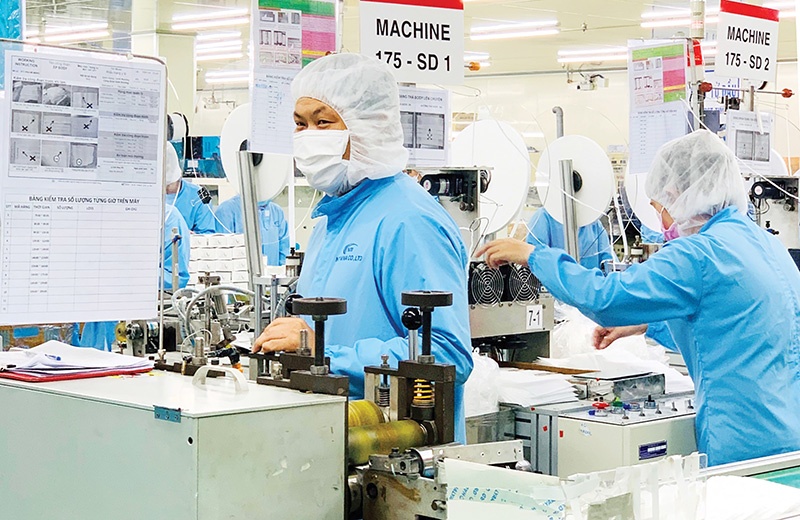South Koreans stay at summit of flow charts
 |
| South Korean investors have contributed much to Vietnam’s economy, Photo: Le Toan |
The Mekong Delta province of Kien Giang is promoting activities to attract South Korean businesses with sufficient resources to invest in agro-fishery, leather shoes, high value-added processing, and renewable energy, as well as waste and wastewater treatment.
Nguyen Duy Linh Thao, director of Kien Giang Investment, Trade and Tourism Promotion Centre said, “Kien Giang wishes to access modern technologies to reduce environmental impacts. We think that South Korean investors, in particular, will have more advantages than domestic investors.”
Tran Huy Quan, director of Thai Binh Department of Industry and Trade, said that good pandemic prevention ensured a safe and effective production and business environment – core factors to attract tourists and capital from South Korea.
Thai Binh, a coastal delta province in the north of Vietnam, is located in the southeast of the Red River Delta. As of October, the province has had 97 foreign-invested projects, of which 24 are from South Korea, with the total registered investment capital of over $83 million.
Investment in many Vietnamese localities by South Korean businesses continues to increase. Kyung Don Kim, head of the Korea Trade-Investment Promotion Agency in Hanoi said, “The areas that our businesses are interested in are mainly manufacturing and trade.”
In Vietnam, South Korean businesses represent the largest investors in the country with a total of 9,165 projects. About 80 per cent of South Korean enterprises are investing in manufacturing, such as Samsung, LG, and Hyundai Motors. During January-December 20, 2021, South Korea was Vietnam’s second largest foreign investor, with the total registered capital of $4.95 billion, accounting for 15.9 per cent of Vietnam’s total registered foreign direct investment of $31.1 billion.
Based on current trends, bilateral trade is expected to reach $70 billion by the end of 2021, an all-time high. South Korea is the third exporter and second importer after the United States and China. In particular, the Korea desks, established in some localities over the past few years, emphasise the effective and substantive investment activities of South Korean businesses in Vietnam.
The localities that receive a lot of investment from South Korean businesses are usually located in the two economic locomotives of the country, as these offer convenient infrastructure, labour conditions, and convenience for the South Korean workers and experts.
“This can lead to risks as they could quickly occupy large chunks of regional markets, as well as on a national scale,” said Bui Thi Hong Ngoc of the Vietnam Economic Institute.
For instance, the increase in investment from Samsung in Vietnam has already led to the group’s satellite businesses filling the supporting industry gap. In the first 10 months of 2021, Samsung’s total revenues from production and business activities in Vietnam hit almost $60.5 billion, while exports reached $53.5 billion. However, only about 50 domestic companies were participating in this success story.
“Acquisitions and domination of foreign enterprises in the local market could lead to losses in sectors like automobiles, cosmetics, and electronics,” Ngoc said. In Vietnam, South Korean corporations pursue treating each investment location as a network of activities, leading to the appearance of many other enterprises that play complementary roles in supporting the corporations.
For example, core corporations, often entail a network of satellite businesses. This strategy helps South Korean investors and businesses support each other and form a closed chain, exploiting local advantages and improving the efficiency of investment activities in Vietnam.
South Korean investment in Vietnam has grown rapidly, showing that the close economic cooperation relationship between the two has become increasingly attractive for investors.
“To more effectively promote investment flows from South Korea in the future, Vietnam needs to have more appropriate and effective investment and management policies, minimising the negative impacts and increasing the number of projects,” Ngoc argued.
What the stars mean:
★ Poor ★ ★ Promising ★★★ Good ★★★★ Very good ★★★★★ Exceptional
Related Contents
Latest News
More News
- Global partnerships key to Vietnam’s IFC development (December 26, 2025 | 16:18)
- Vingroup pulls out of bid to invest in North-South high-speed railway (December 26, 2025 | 11:42)
- Strengthening supply chains through trade promotions and customs reform (December 24, 2025 | 14:00)
- PM orders investment model for North–South high-speed rail (December 22, 2025 | 17:43)
- LS Eco Energy to invest in Vietnam rare earth sector (December 22, 2025 | 17:31)
- Government moves to establish International Financial Centre (December 21, 2025 | 21:00)
- Vietnam's IFC to target global investment flows (December 21, 2025 | 18:00)
- Two national hospitals expand capacity with new facilities (December 20, 2025 | 09:00)
- Ha Tinh breaks ground on major Vingroup industrial and energy projects (December 19, 2025 | 18:24)
- EVN launches major power infrastructure projects nationwide (December 19, 2025 | 18:17)

 Tag:
Tag:





















 Mobile Version
Mobile Version